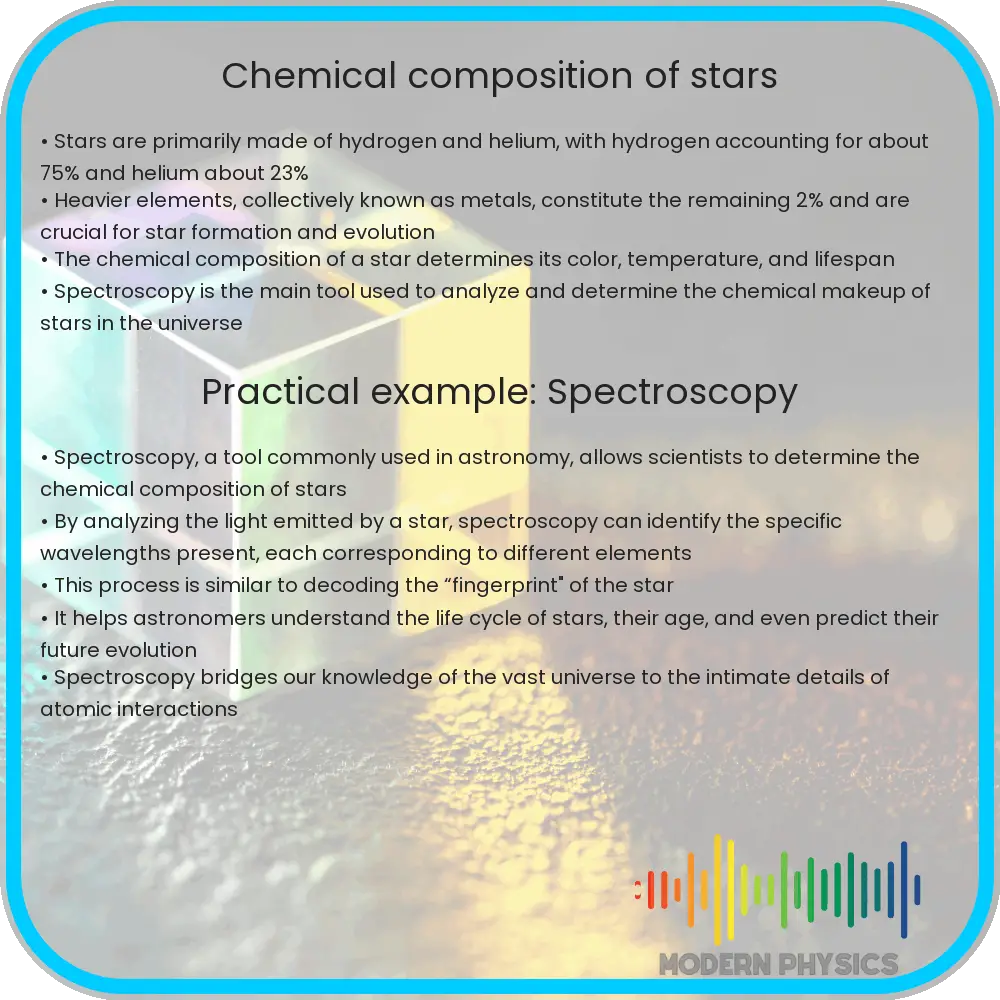Explore the fascinating world of stars: their chemical composition, the role of spectra in identifying elements, and the transformative power of nuclear fusion.

Chemical Composition of Stars: Elements, Spectra & Fusion
The chemical composition of stars is a window into the processes that govern the universe. Stars, the primary constituents of galaxies, are primarily composed of hydrogen (H) and helium (He), with traces of heavier elements. This composition is not arbitrary but a result of cosmic evolution and stellar processes.
Elements in Stars
At the core of stellar chemistry are hydrogen and helium, making up approximately 75% and 23% of the Sun’s mass, respectively. These percentages vary in other stars depending on their age and size. Heavier elements, referred to as ‘metals’ in astronomical terms, account for a smaller fraction but are crucial for star formation and evolution. Elements like oxygen (O), carbon (C), neon (Ne), and iron (Fe) are among the most abundant in stars after H and He.
Stellar Spectra
The chemical composition of a star can be determined through its spectrum. When a star’s light is dispersed, it forms a spectrum that contains dark lines known as absorption lines. Each line corresponds to a specific element in the star’s atmosphere, with its position and strength revealing the element’s abundance and the star’s temperature. This technique, known as spectroscopy, allows astronomers to analyze the light from stars to identify their chemical compositions and physical properties.
Nuclear Fusion in Stars
The heart of a star is a furnace of nuclear fusion, where lighter elements combine to form heavier ones, a process that releases vast amounts of energy. In the Sun and similar stars, fusion occurs primarily through the proton-proton chain, converting hydrogen into helium. This process can be represented as:
- 4 1H → 4He + 2e+ + 2νe + energy
This reaction not only powers the star but also leads to the synthesis of new elements, contributing to the chemical diversity observed in the universe. As stars evolve, they can initiate other fusion processes, creating heavier elements up to iron in their cores.
Stellar Life Cycle and Elemental Synthesis
As stars age, their chemical compositions change. In massive stars, once hydrogen is depleted, fusion progresses to heavier elements like helium, carbon, and oxygen, ultimately leading to the creation of iron. This series of fusion reactions enriches the star’s outer layers with heavier elements, contributing significantly to the chemical diversity observed in the universe.
During the later stages of a star’s life, particularly in supernova explosions, elements heavier than iron are formed. These cataclysmic events scatter these elements into space, seeding future generations of stars and planetary systems. Thus, the life cycle of stars is a key process in the cosmic chemical evolution, making elements like carbon, which is essential to life as we know it, and precious metals like gold and platinum.
The Importance of Stellar Chemistry
Understanding the chemical composition of stars is crucial for several reasons. It not only helps in determining the ages and distances of stars but also in understanding the history and evolution of galaxies. The chemical fingerprints left by stars allow astronomers to trace the processes of nucleosynthesis, providing insights into the Big Bang and the formation of the universe.
Moreover, by studying the elemental makeup of stars, scientists can also infer the potential for habitable planets around these stars. The presence of elements such as carbon, oxygen, and nitrogen is critical for the development of life as we know it. Therefore, stellar chemistry plays a vital role in the search for extraterrestrial life.
Conclusion
The study of the chemical composition of stars offers profound insights into the workings of the universe. From the nuclear fusion reactions at the heart of stars to the cataclysmic supernovae that seed the cosmos with heavy elements, the lifecycle of stars is fundamentally linked to the chemical evolution of the universe. Through the lens of stellar spectra and the principles of nuclear fusion, astronomers unravel the mysteries of stellar compositions, paving the way for understanding everything from the genesis of elements to the potential for life on other planets. The stars, in their fiery splendor, are not just points of light in the night sky but are the forges of the universe’s diversity, crafting the very elements that make up the world around us.
